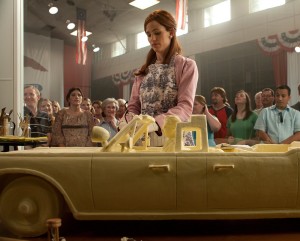Butter disappoints with shallow themes
Every year at the Iowa State Fair in Des Moines, one culinary artist continues a tradition that’s been upheld for more than a century. This master of dairy sculptures carves what has famously been titled the “Butter Cow,” a 600-pound statue made entirely of butter and an interior wooden-metal framework. Uniquely created dairy sculptures — most notably John Wayne, Harry Potter and Elvis Presley — usually accompany the cow at every fair.

Butter buggy · Jennifer Garner carves up an automobile sculpture as Laura Pickler in her latest film Butter. This marks the first time the actress has produced a film under her production company Vandalia Films. – | Photo courtesy of Radius Films
Young screenwriter Jason Micallef discovered the incredibly intense and competitive world of butter carvings on a summer road trip with several college classmates. Upon observing the dedication and passion behind each piece of butter artwork, Micallef thought these contests made the perfect topic for a feature film. After employing some creative freedom and adding his own fictional twist, the screenplay for Butter was born.
Butter follows the story of Laura Pickler (Jennifer Garner), the wife of butter sculpting icon Bob Pickler (Ty Burrell). After her husband’s sudden retirement from competition, Laura enters a butter sculpting contest to preserve the Pickler name. Assuming she would move unmatched to the State Fair showcase, Pickler is surprised to find an eclectic group of opponents in her way.
These competitors include 10-year-old Destiny (played by film newcomer Yara Shahidi), Bob’s free-spirited mistress Brooke (Olivia Wilde) and butter sculpture super-fan Carol-Ann (Kristen Schaal). From here, Butter becomes a tale of “politics, ambition, greed, sex, race and family,” as described by Laura in the film’s opening scene.
Micallef’s script was immediately met with praise and intrigue from filmmakers and studio executives for its unique concept. Michael De Luca, the Oscar-nominated producer of films such as Moneyball and The Social Network, and his partner Alissa Phillips quickly optioned Butter for production. By the end of 2008 Butter was included on Leonard Franklin’s “Black List” as the third best un-produced screenplay of the year.
Once financed, Butter drew the attention of actress Jennifer Garner for the leading role of Laura Pickler. Garner thought so highly of the script that she not only starred, but also produced Butter as the first film from her upstart production company, Vandalia Films. After securing Garner as the protagonist, De Luca then tapped Jim Field Smith for the director’s chair and signed an all star comedic cast for supporting roles.
All this considered, it’s no wonder that audiences might expect a bit more from the final version. Though the film shines in terms of characterization and visual design, Butter fails to live up to its potential.
The audience can almost immediately identify the political notions of Butter through the character of Laura, who speaks in a tone of superiority. Laura’s voiceover monologues almost speak down to the viewer, indicating how little she thinks of others and how highly she sees herself. Laura’s style of dress similarly invokes the wardrobe of a politician’s wife. Fitted with pearl necklaces, ironed sundresses and disturbingly pristine hair, Laura looks as though she belongs on campaign bus rather than in a butter carving cooler.
Still, the powerful character depictions, through means not traditionally utilized in comedies for player development, are one of the strengths of Micallef’s script and of the costume designer, Susie DeSanto. DeSanto and Micallef cooperatively develop and form the unique personae of each character through appropriate visual details such as wallpapered floral patterns on Pickler’s starched-stiff dress suits and pastel-colored cardigans buttoned up to her chin. In this way, audiences can understand a character’s personality just by looking at their costumes onscreen and remain interested in the film as they take in visual and literary character clues for the entire run time.
Many of the laughs found in Butter — and there is much hilarity in this film — come from the exaggerated parodic characters Micallef has imagined. Since Butter falls into the category of dark satire-comedy, the audience laughs not at the humor of the situation, but at how disturbing and crude the actions of the characters are. Some of Pickler’s lines in this movie when describing different types of people are scarily funny, simply because they are extreme examples of actual prejudices people have today.
Where this film falters and ultimately fails is in the strange construction of the plot and a hugely missed opportunity to satirize the poor state of American politics. Micallef begins this film quite well; he strongly establishes the characters and entertains the audiences with good comedy. As the film progresses, however, the humor weakens and the plot becomes repetitive in some places and just plain strange in others.
It seems as though Micallef initially had a good concept behind the movie and compelling characters to surround it, but perhaps didn’t fully conceptualize where the film would go from there. As a result, the themes of the film are less than effective. The notion of political satire is only minimally touched upon, which greatly underwhelms. Some viewers might interpret Laura Pickler as a critique of the Republican political personage, but Micallef doesn’t analyze her deeper than this surface parallel.
With Butter, as is the case with many recent comedies, the plot falls second to getting big laughs from the audience. Though there is good humor in Butter, one would expect this film to contain bigger themes and fulfill its potential as a witty satire.
Instead, the film just falls into the enjoyable fall comedy category.
